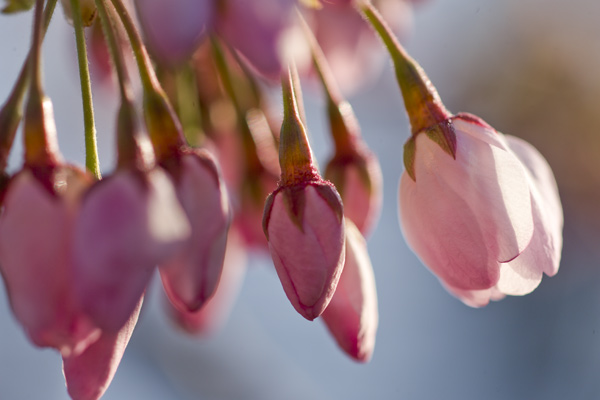Forced flowering branches provide fragrance, color Coaxing Spring


Cherry blossoms begin to open.
By Linda Dolak
OSU Ext. Master Gardener Volunteer
We’re all usually a “bit” tired of winter by this time of year. So if you’re eager for spring, bring it into your home by “forcing” spring branches into bloom. A tall vase of blooming branches can chase away the winter blahs.
Forcing is a process by which the plant is fooled into thinking conditions are spring-like. Although most outdoor branches can be forced, the flowering ones are most impressive. Forsythia is thought to be one of the easiest to force, although flowering cherry, pear and quince are often successful and give off a lovely fragrance, producing a variety of pale pink, red and white flowers. Don’t forget the pussy willows, as well as red twig dogwood, redbud, Chinese or lacebark elm, apricot, apple and most viburnums. All of these can be forced with few problems.
Choose branches with the plumpest buds because the larger the bud, the quicker it will open. Cut branches in early afternoon when temperatures are above freezing. When pruning, be selective so you maintain the plant’s shape. Branches should be about 10 to 12 inches. Prune uniformly throughout and around the plant. Cut various branches at various times for a variety of blooms and color indoors. After cutting the branches, soak them for several hours or overnight in the bathtub in warm water. Branches must be completely submerged with their ends under water. The soaking process softens the flower buds, allowing for easier forcing.
Cut about an inch from the branches, and put them in a bucket or large container of warm water to aid in the quick uptake of water. Make one or two slits in the bottom of the stem before placing it in water. It will look like a cross or a star pattern when looking at the stem from the bottom. Keep the branches in the water in a cool area (60-65 degrees). To assure the water stays clean, change it every two to three days. If possible, keep the branches near a humidifier, or mist them, because low humidity will cause the buds to fall off, as will direct sunlight. The branches need bright but indirect light. When the buds begin to show color, the branches can be put into arrangements. Using a floral preservative, available at garden stores or florists, may increase the “vase” life of the branches. Purdue University offers this formula for making your own: 2 cups lemon-lime soda, 2 cups water, Ω teaspoon household chlorine bleach. Also, moving the arrangement to a cooler location at night will help it last longer. If you turn your thermostat down at night, there’s be no need to move it.
Some branches may develop roots. These can be used for a new plant. Remove the branch and plant in an individual pot, keeping the soil moist until permanent roots are formed. When the warm weather arrives, the new plant can be planted outside, though chance of growth is not guaranteed.
For additional information, visit go.osu.edu/forcingbranches.
 43
43
